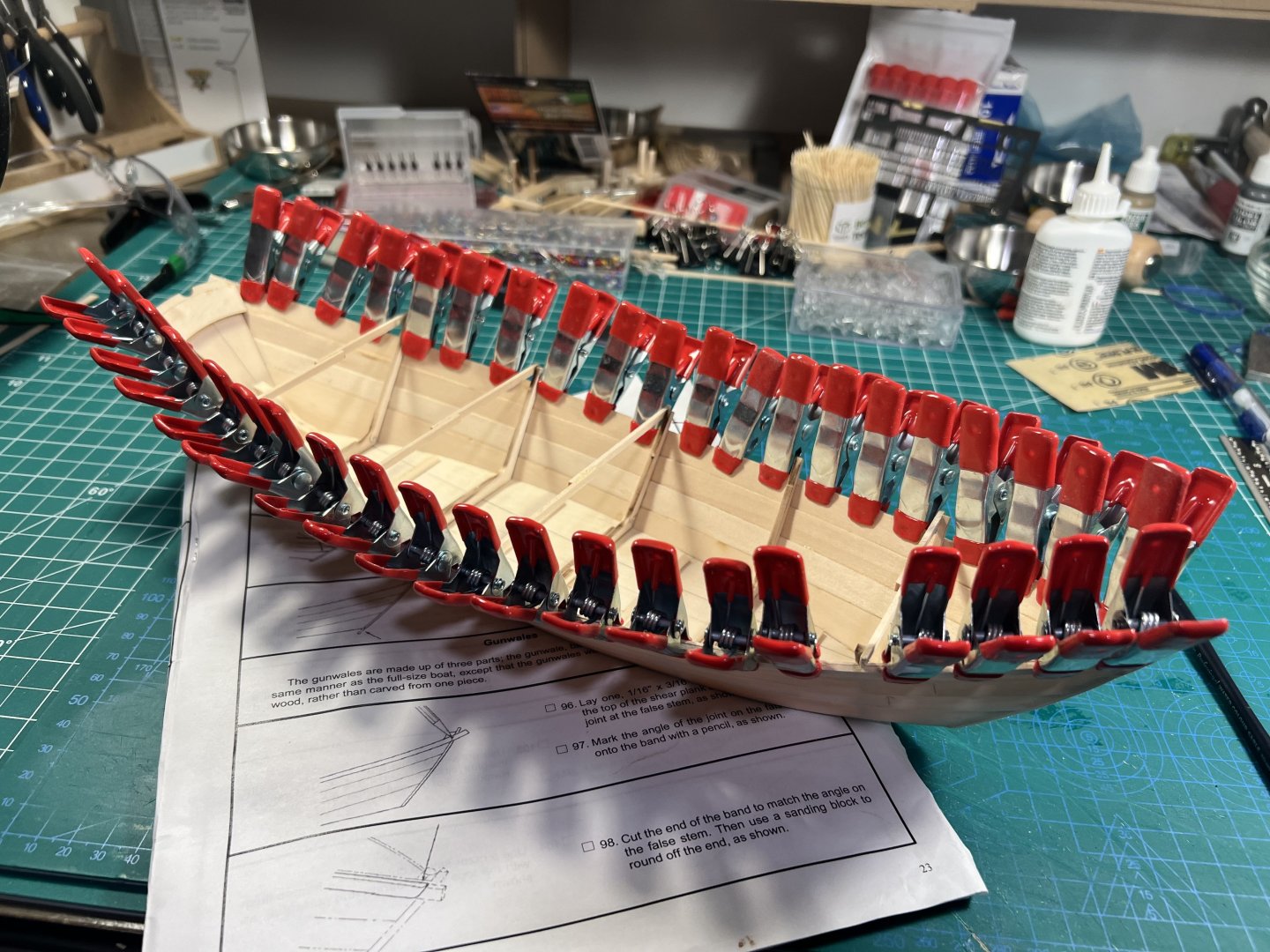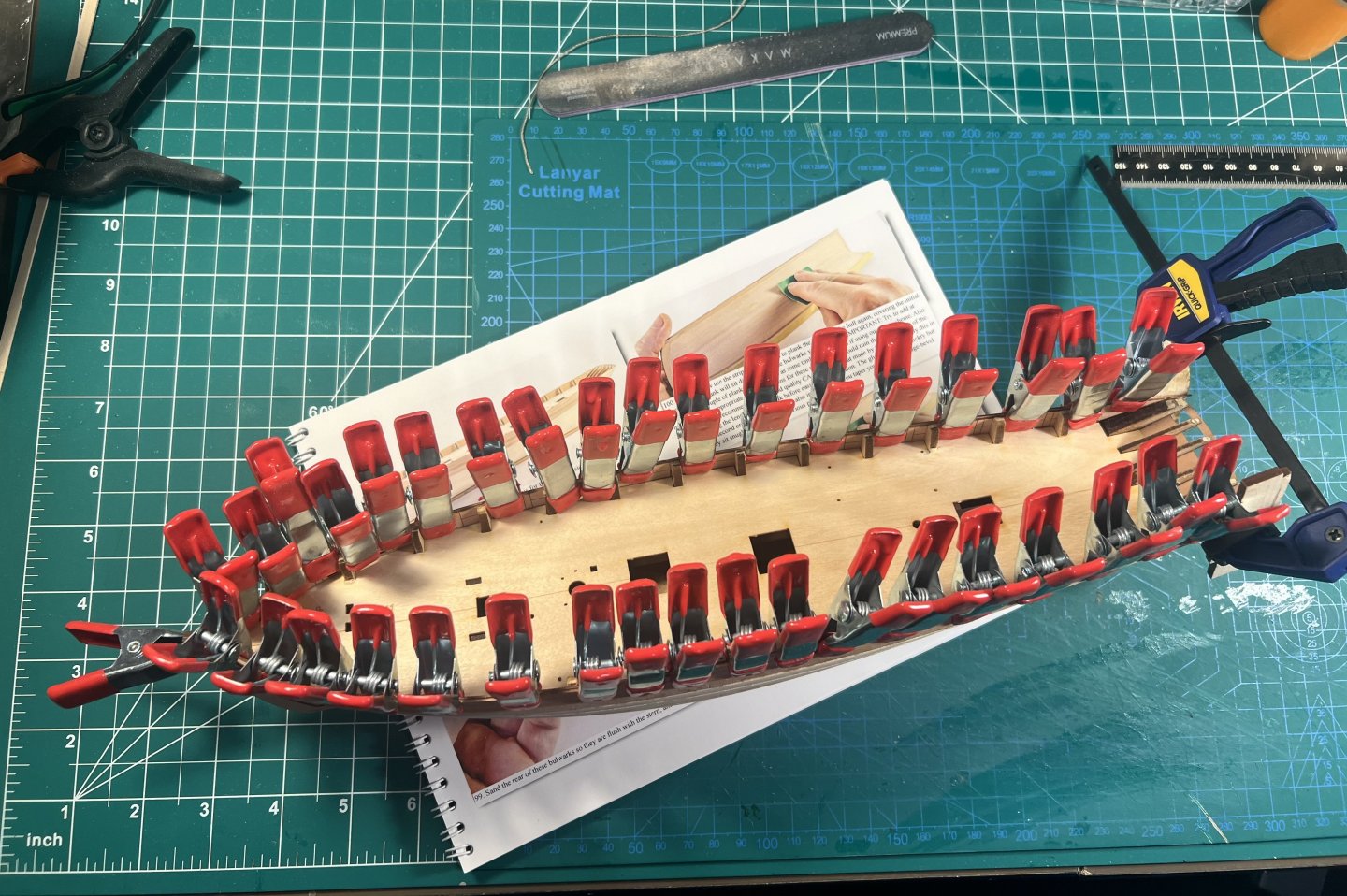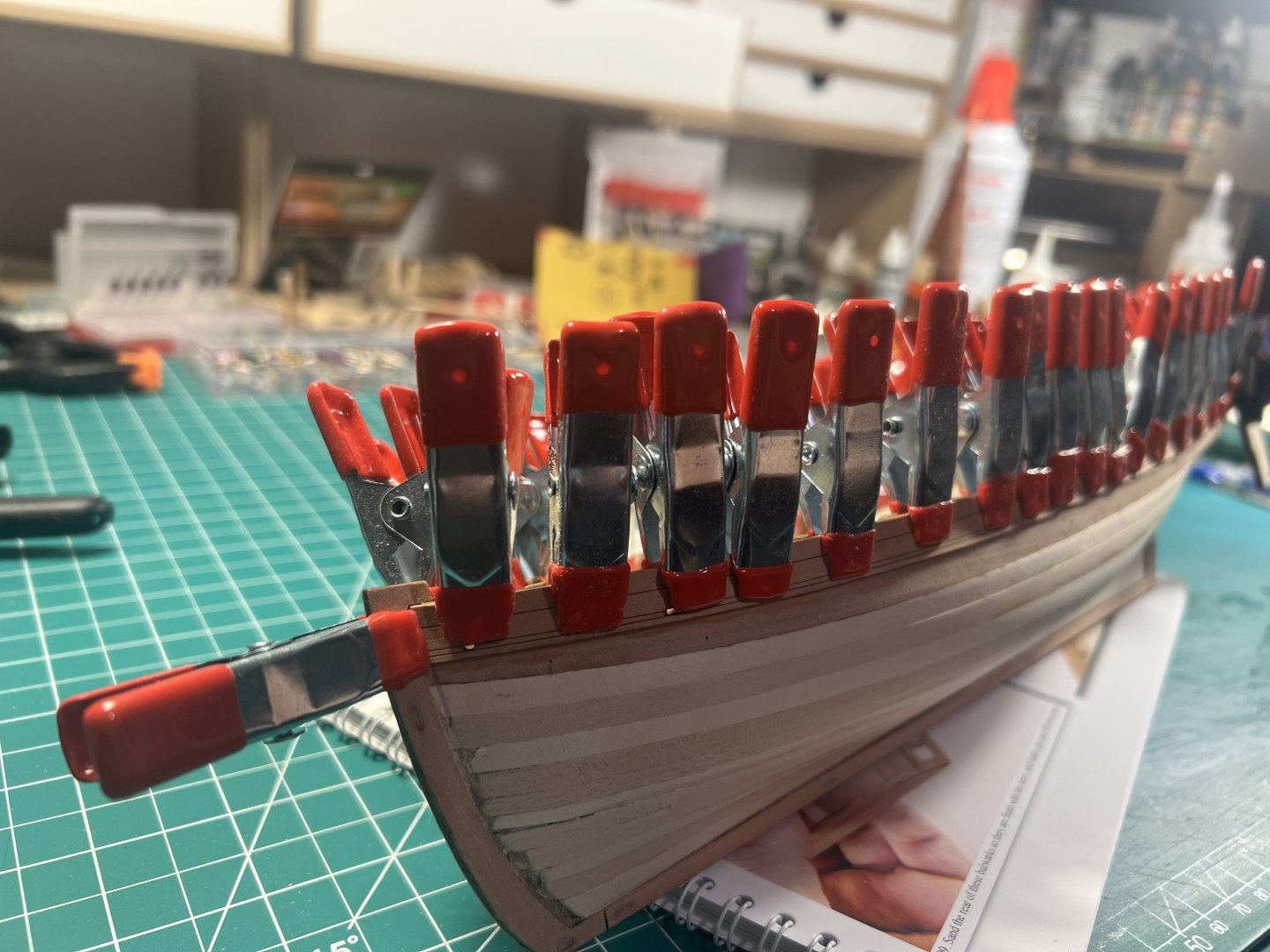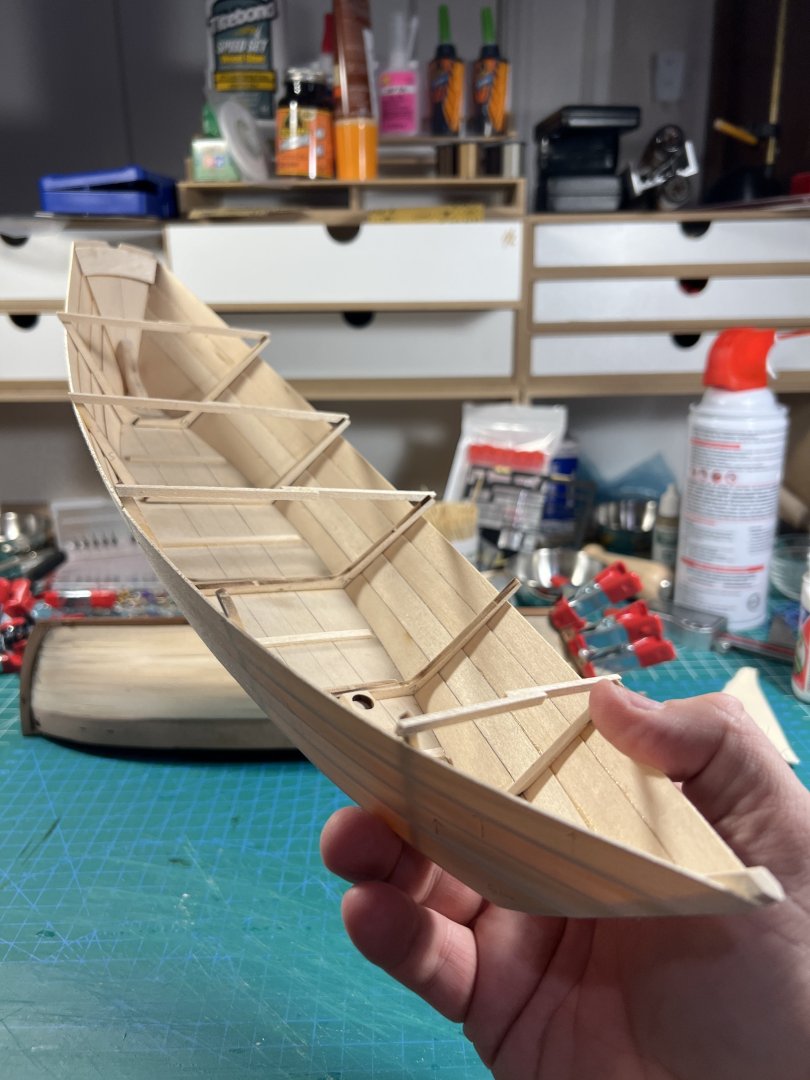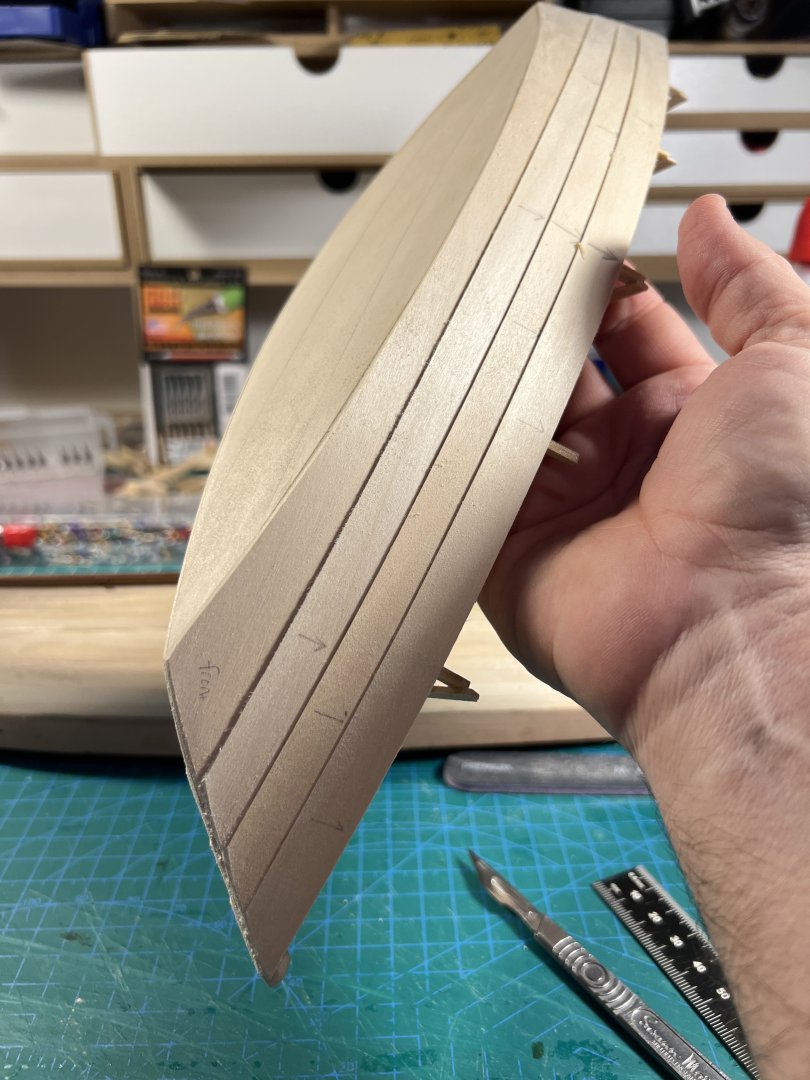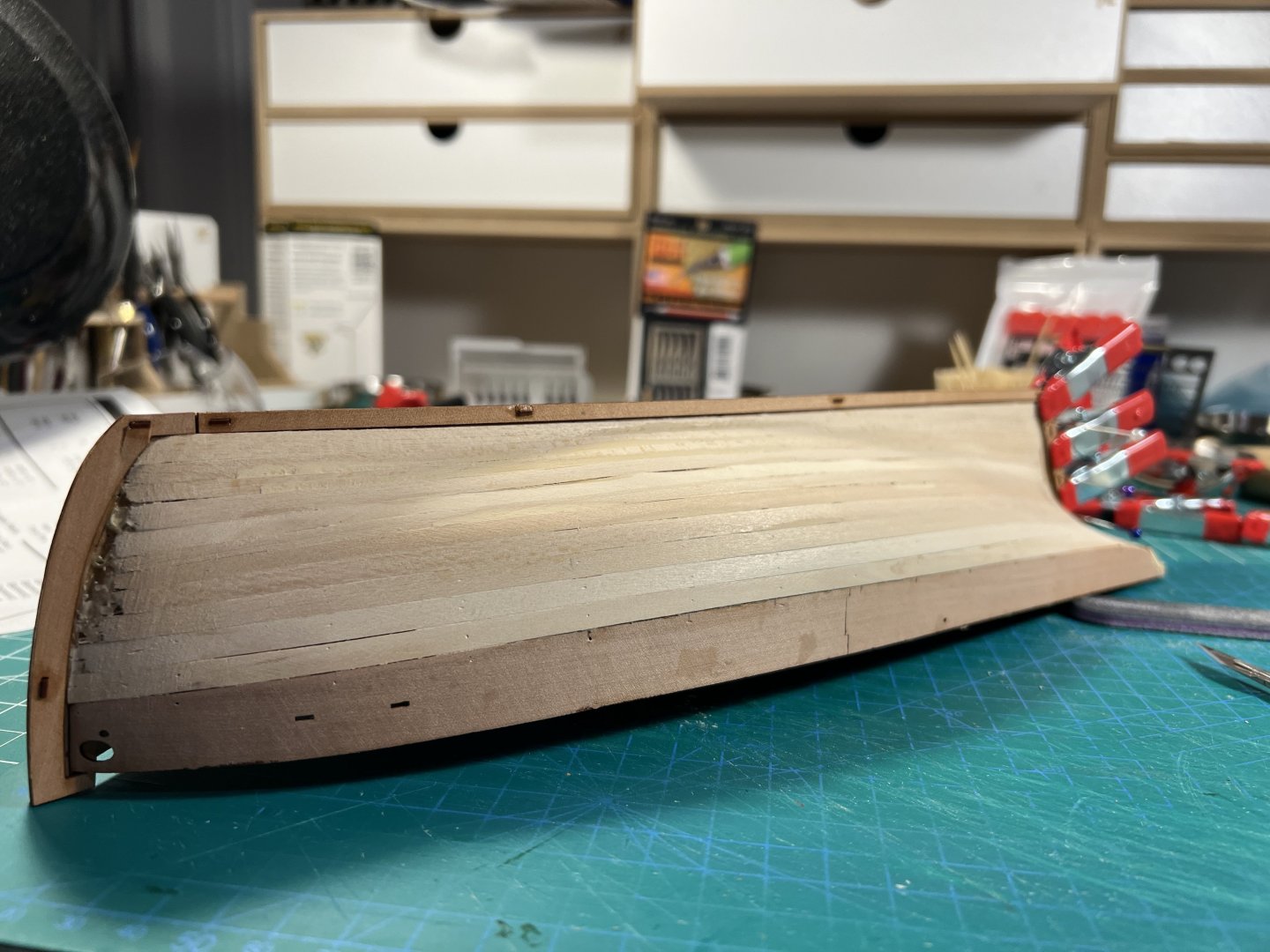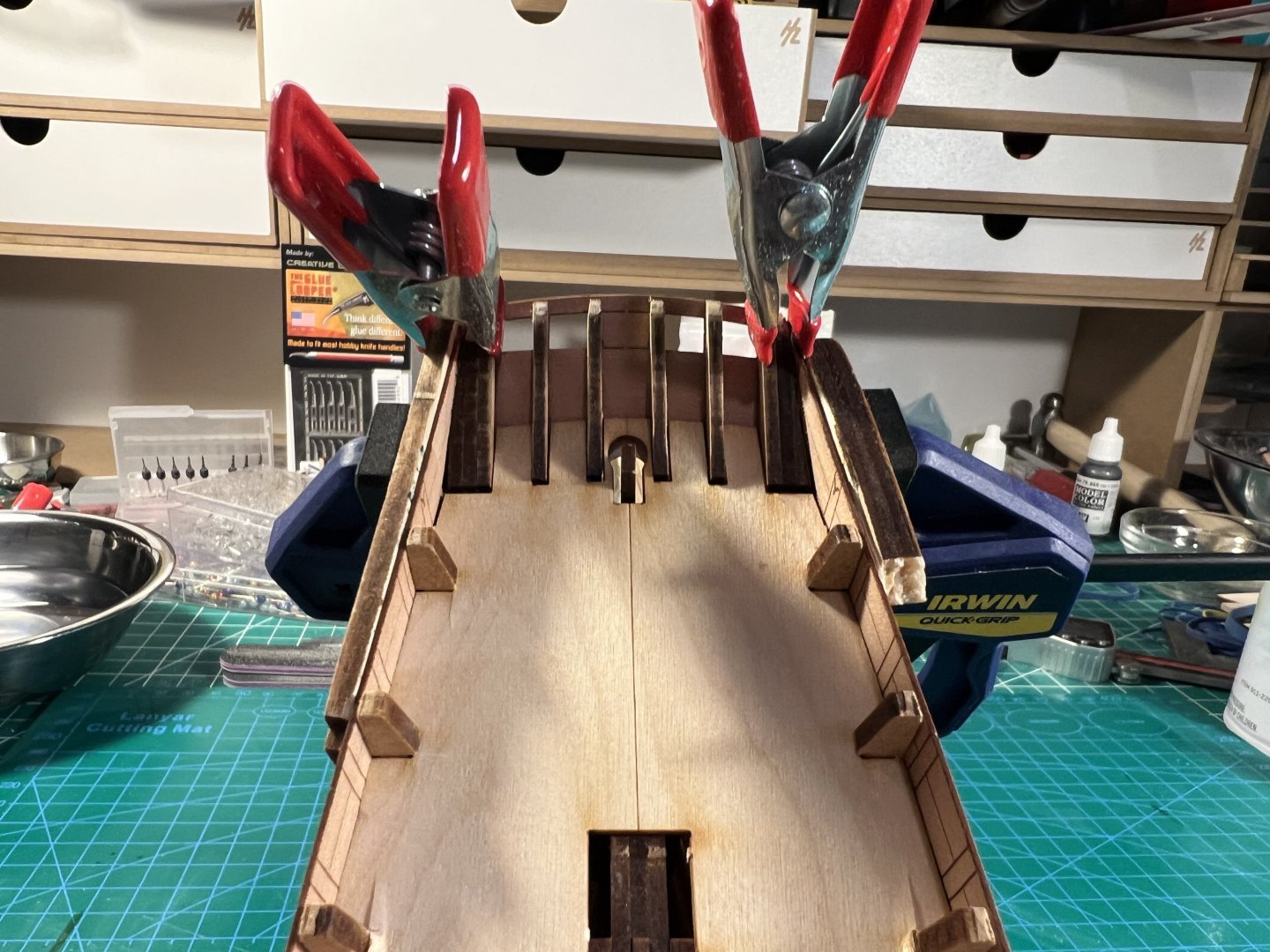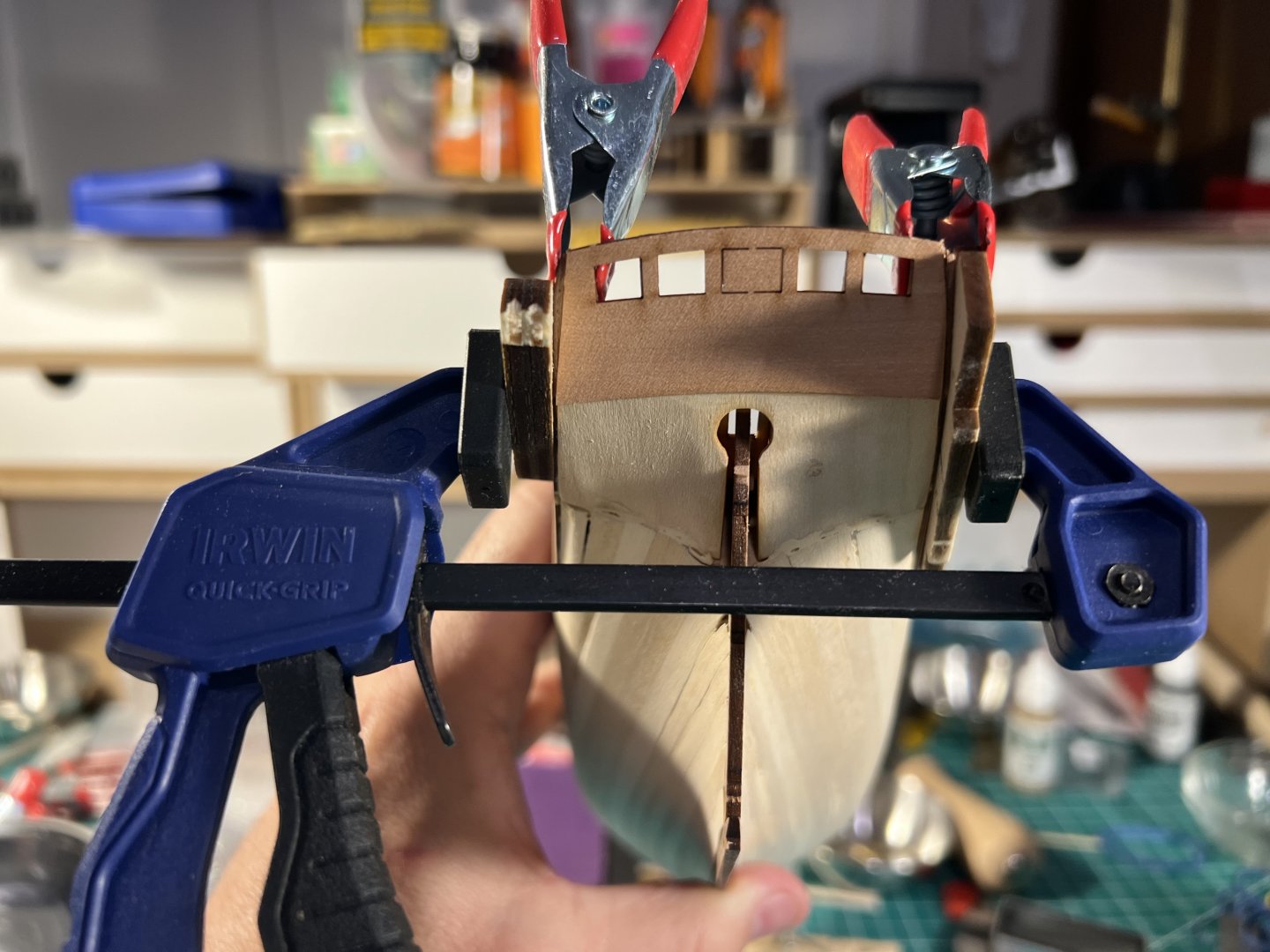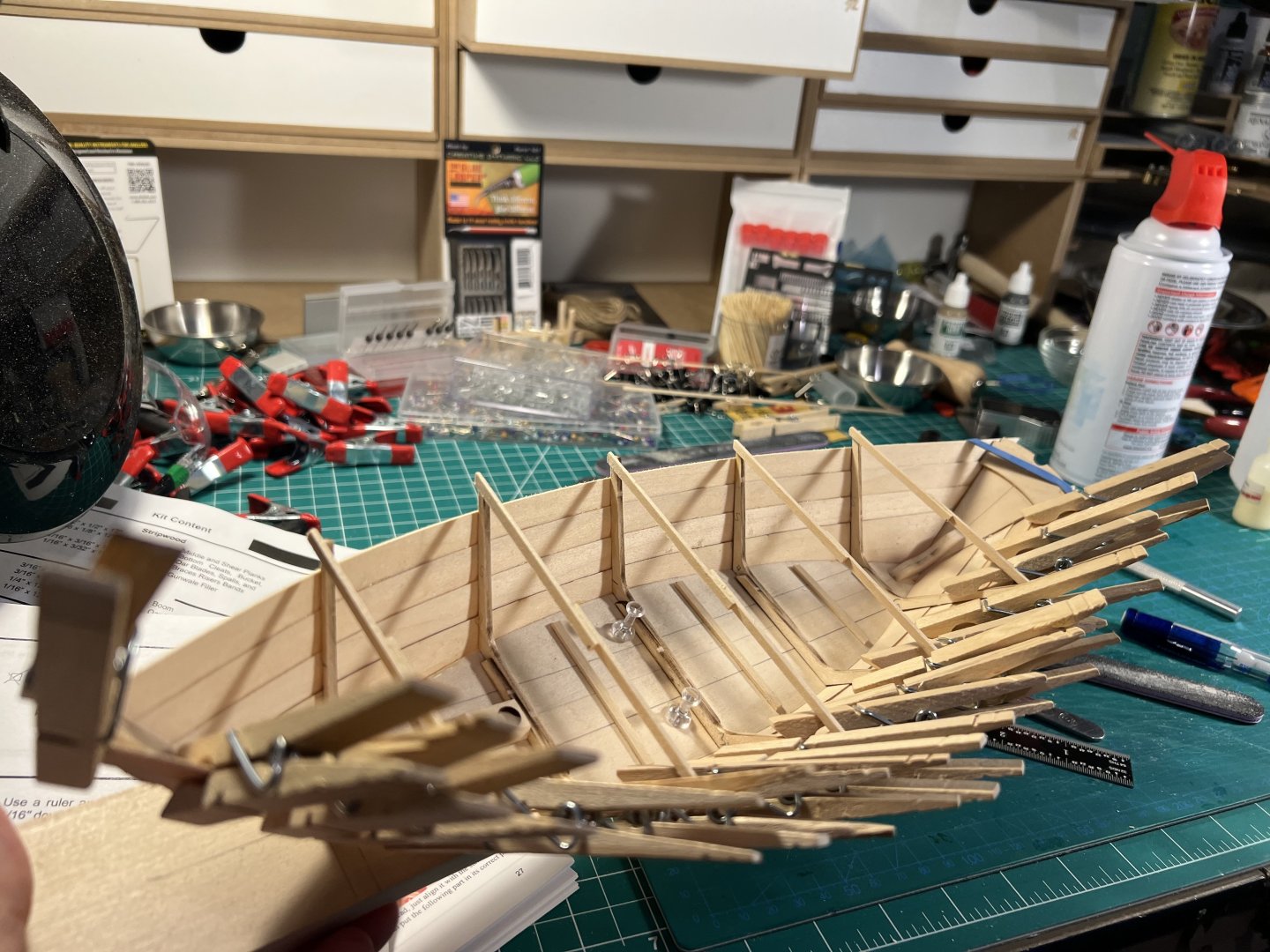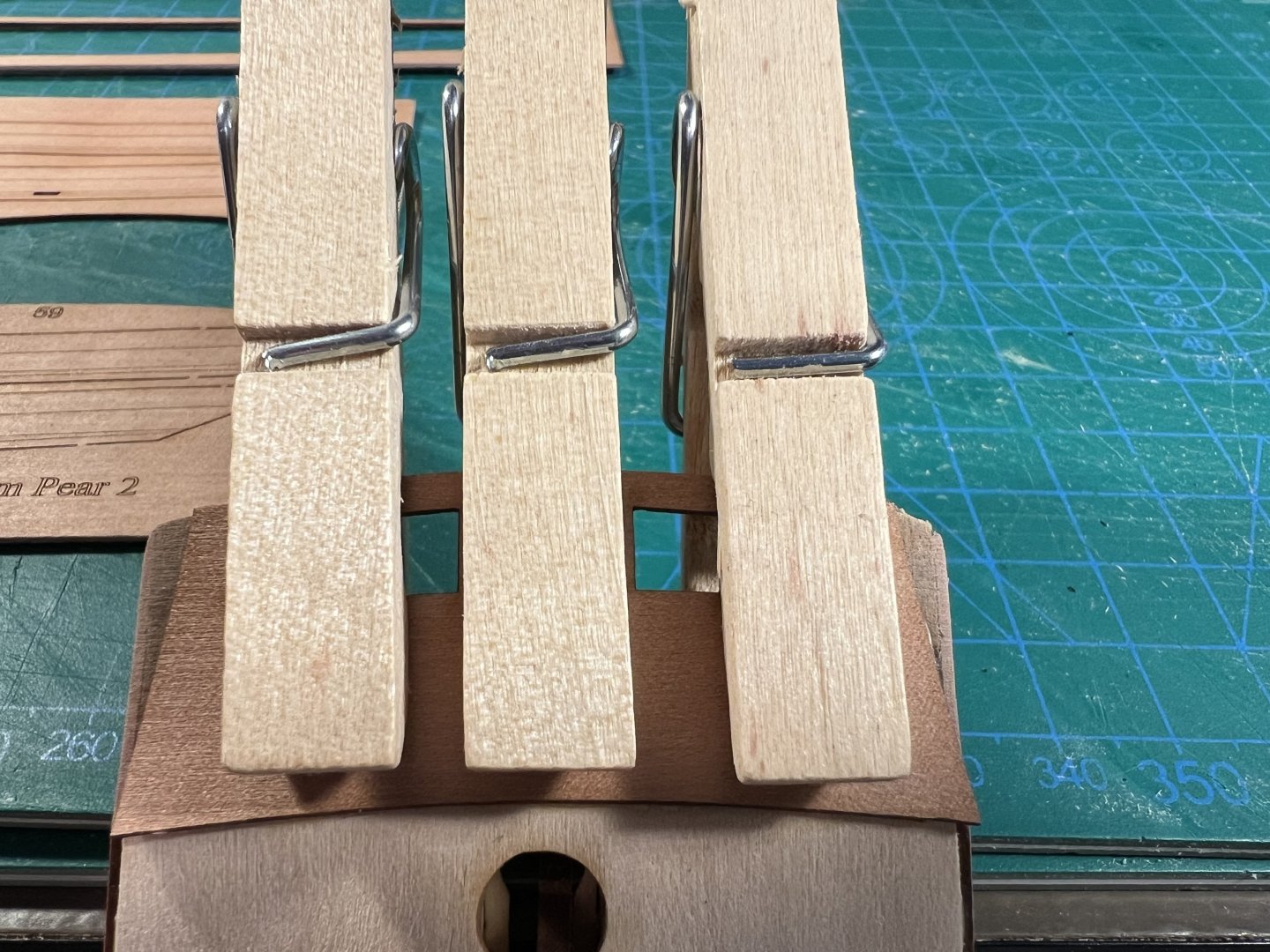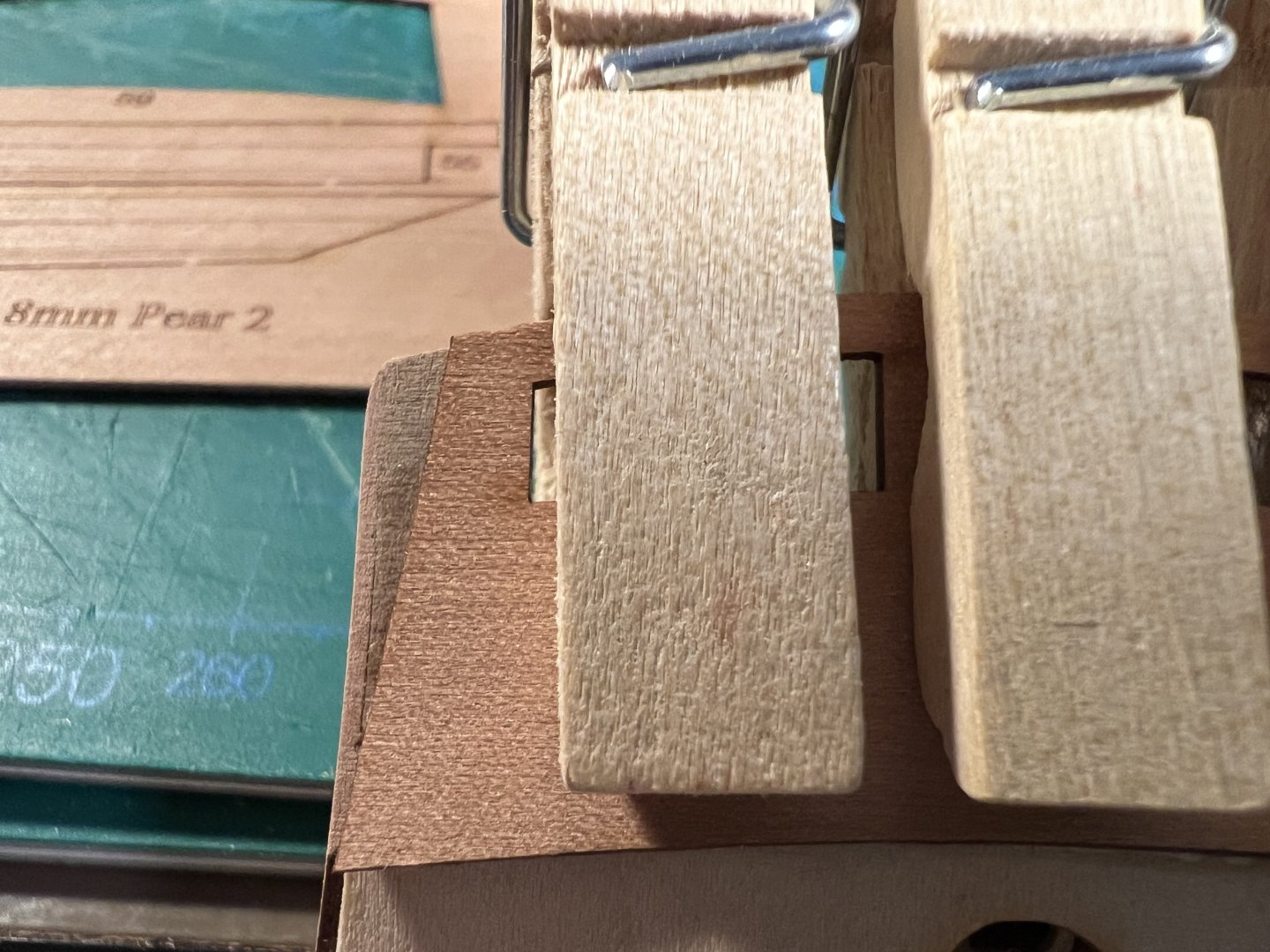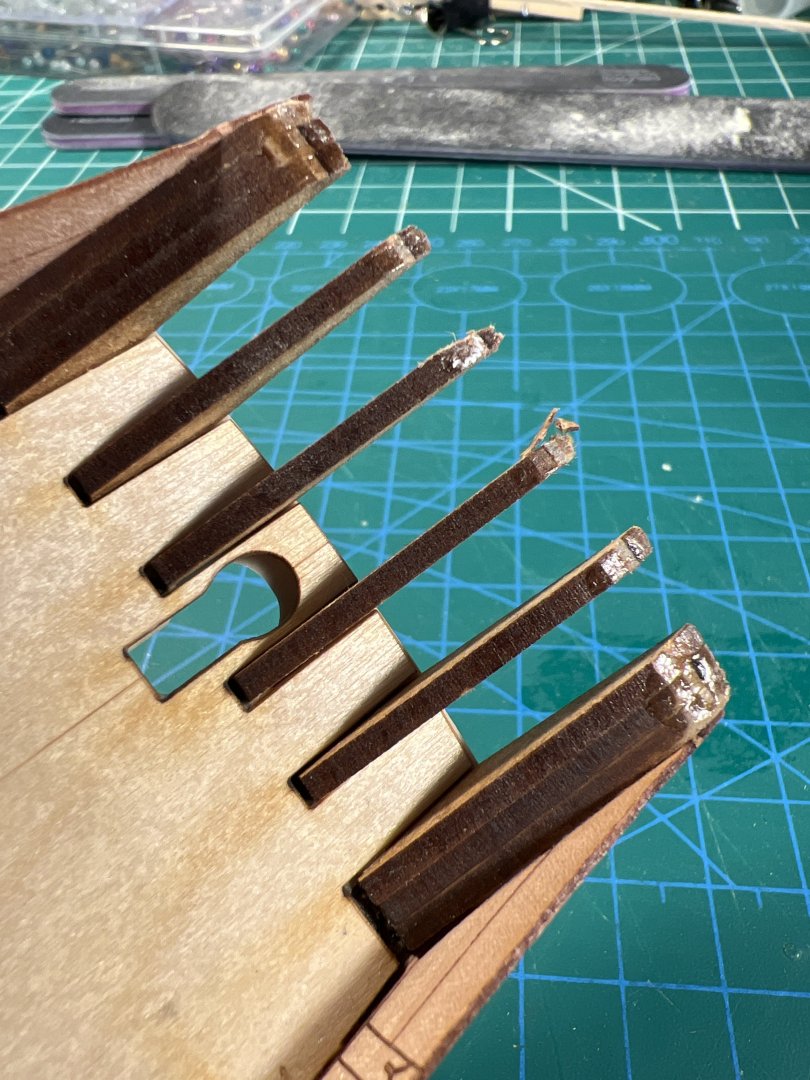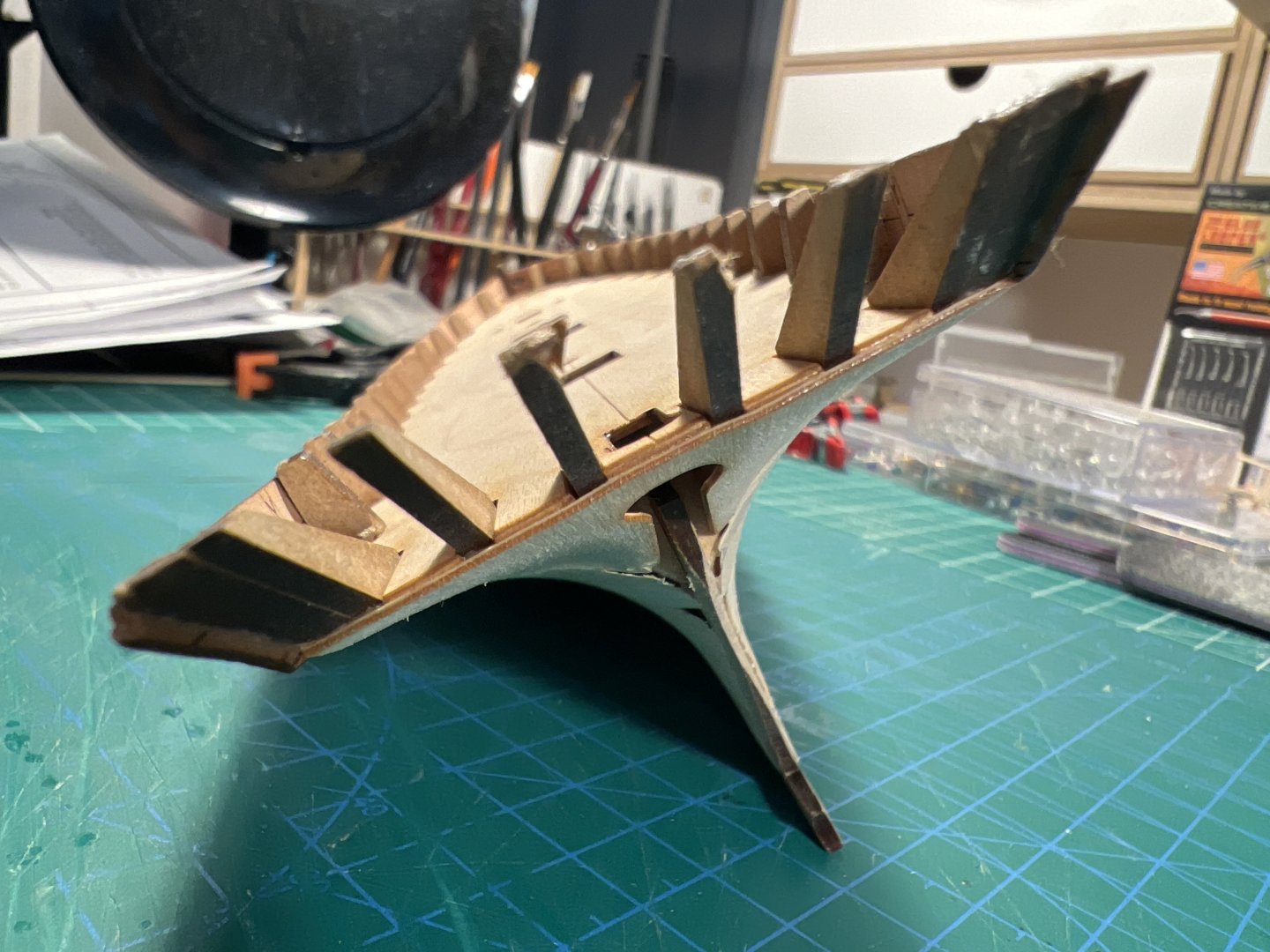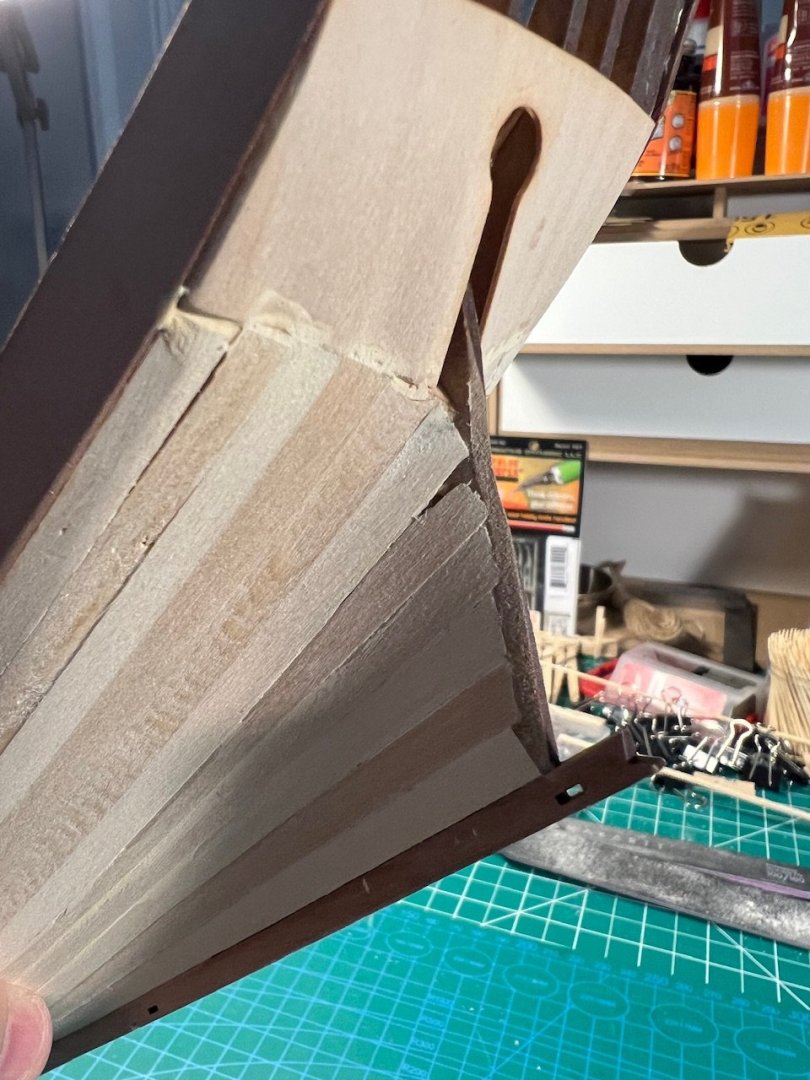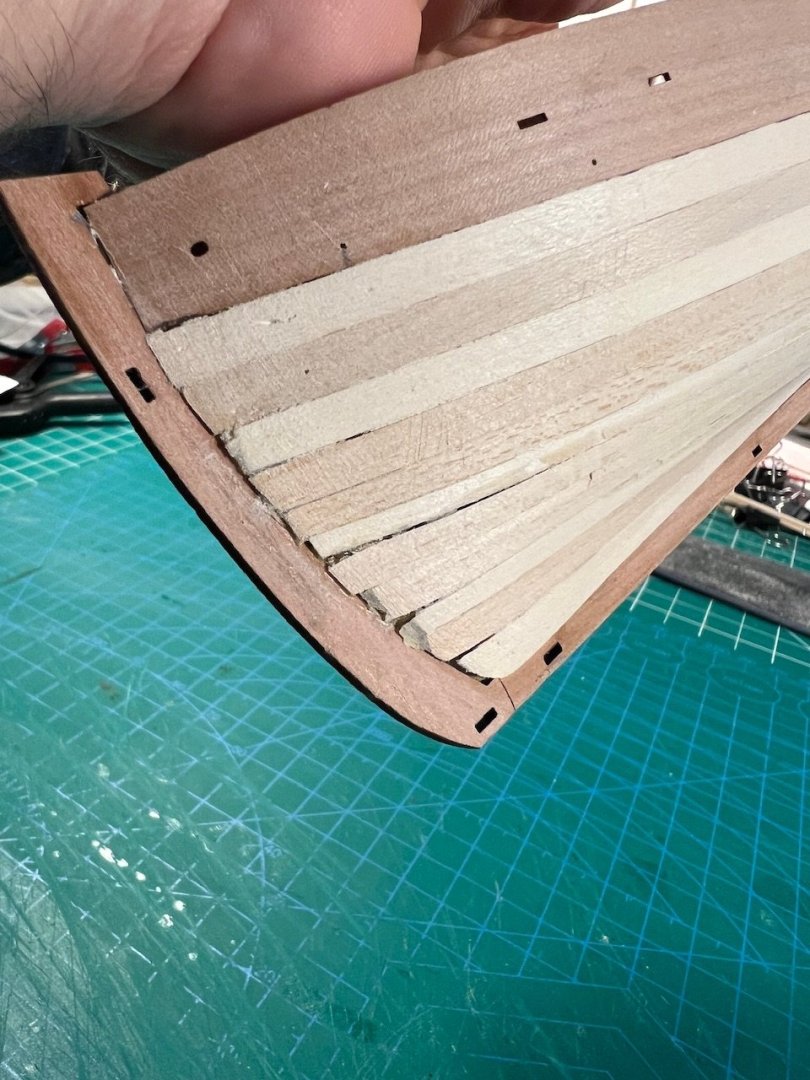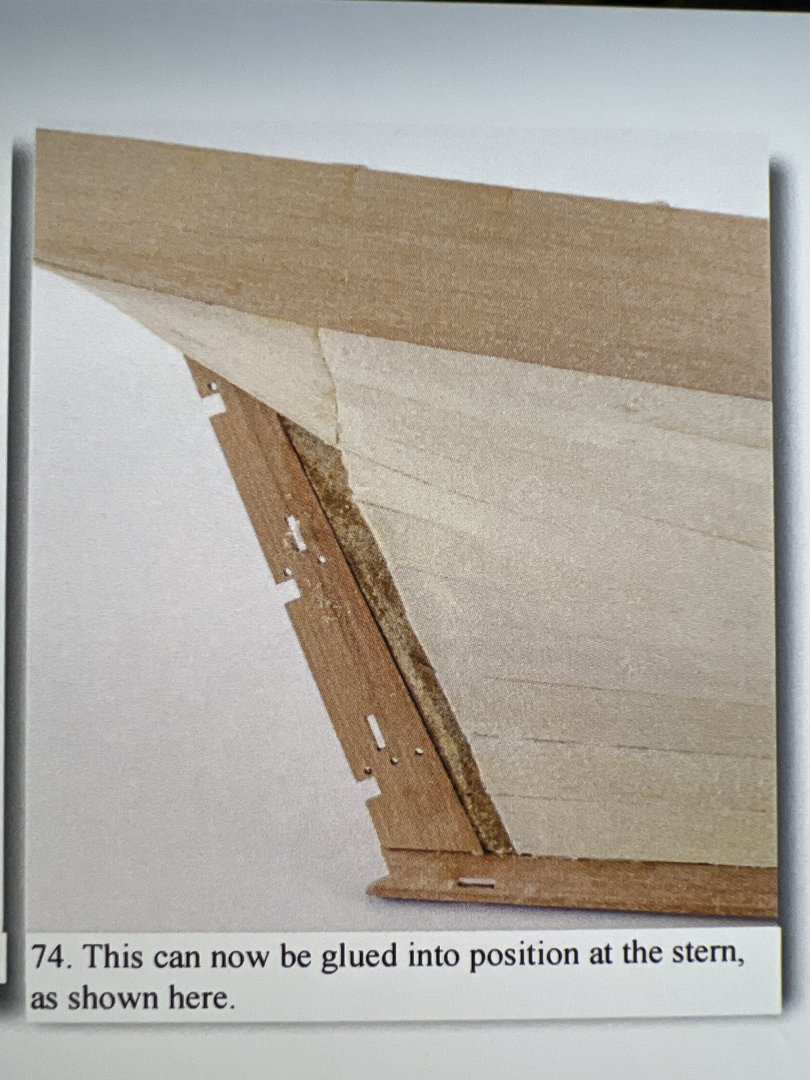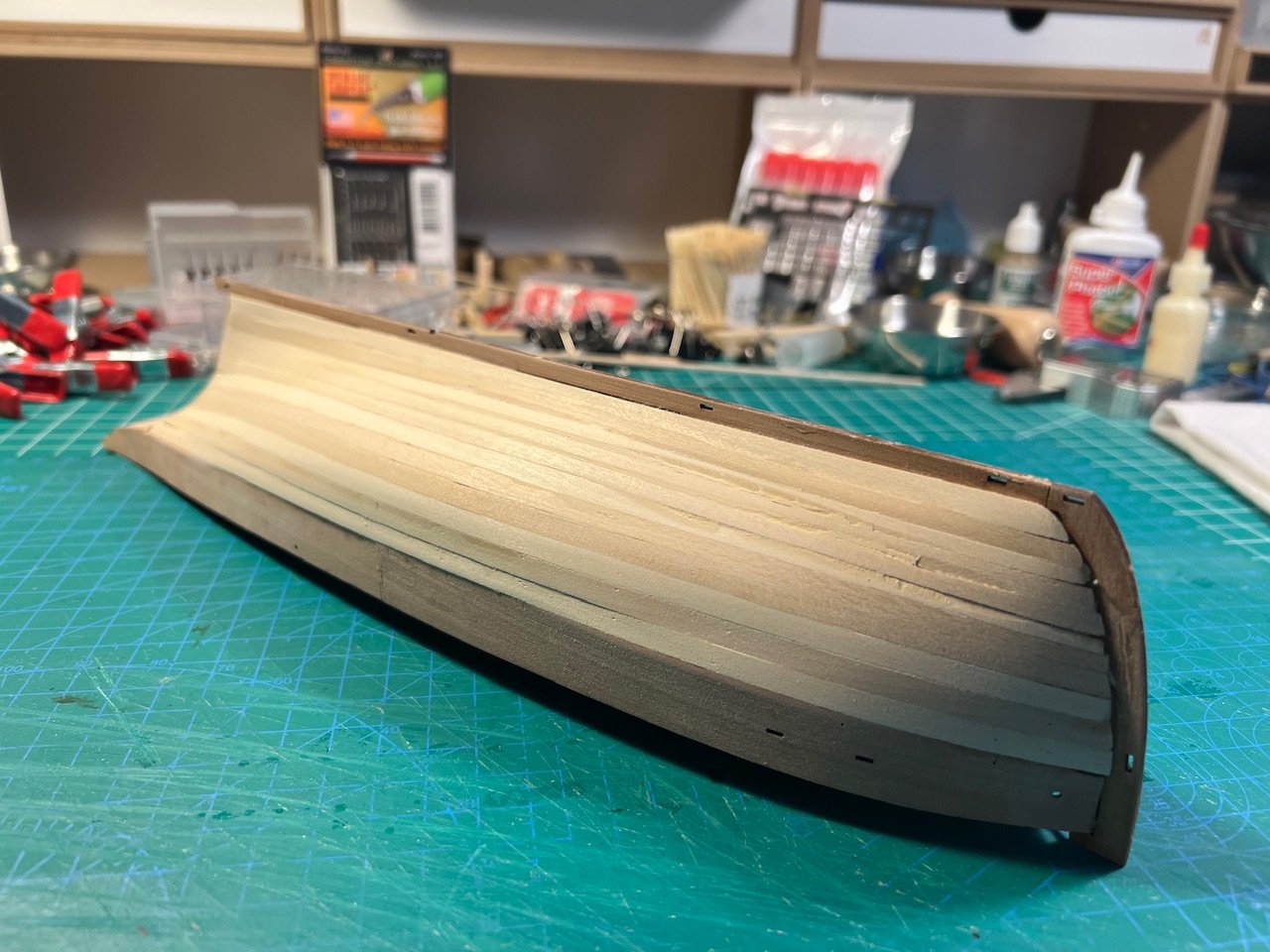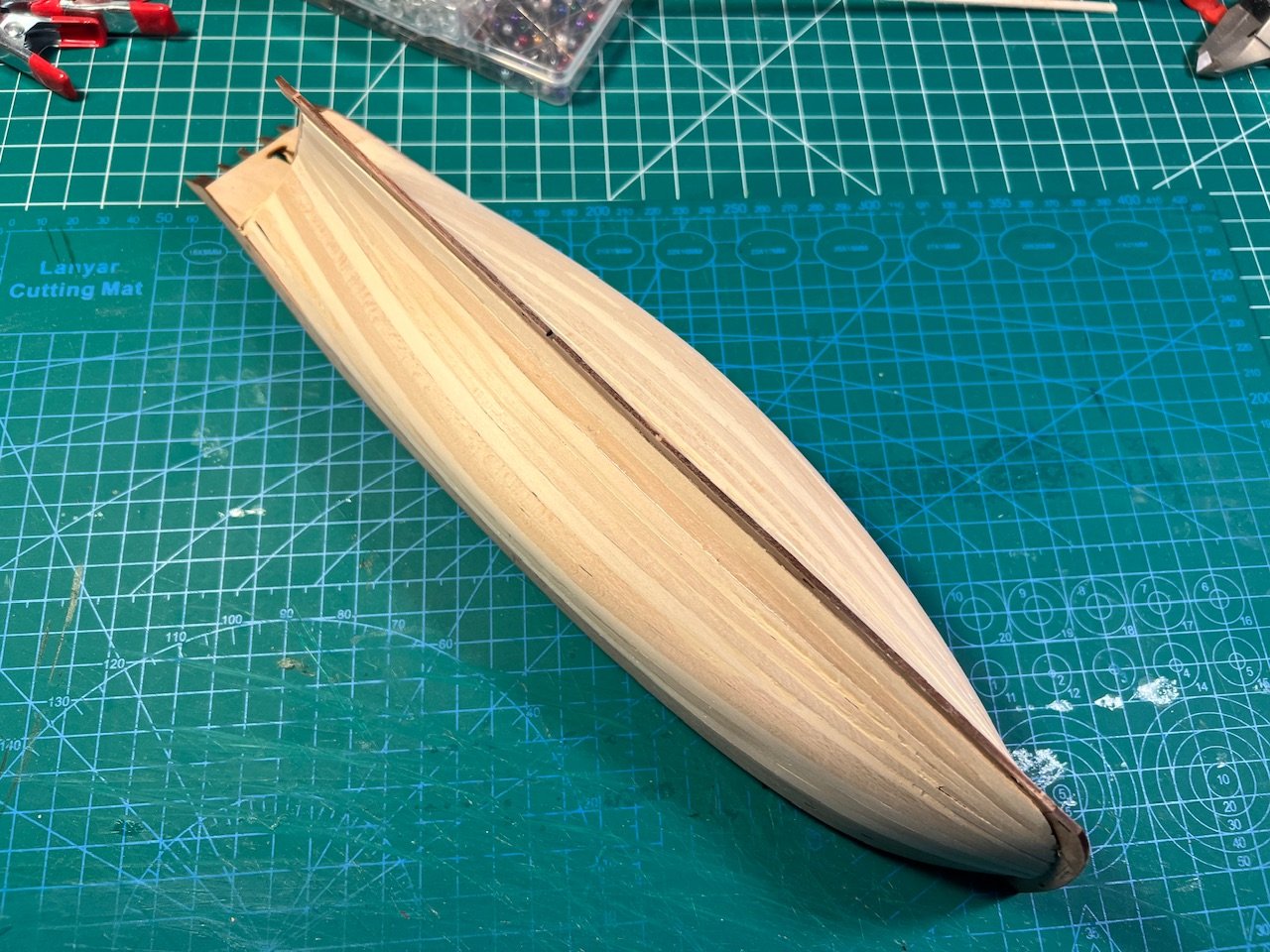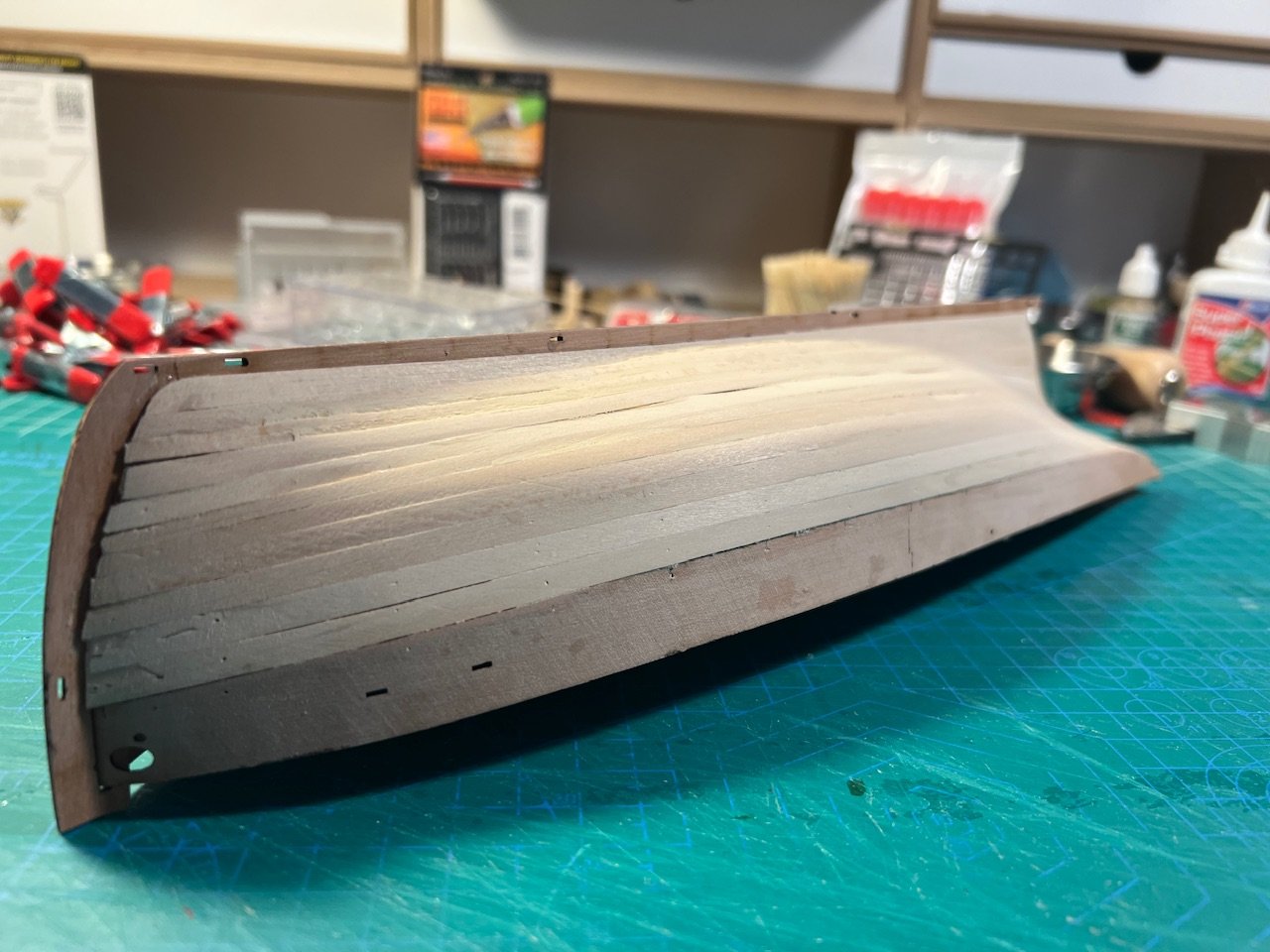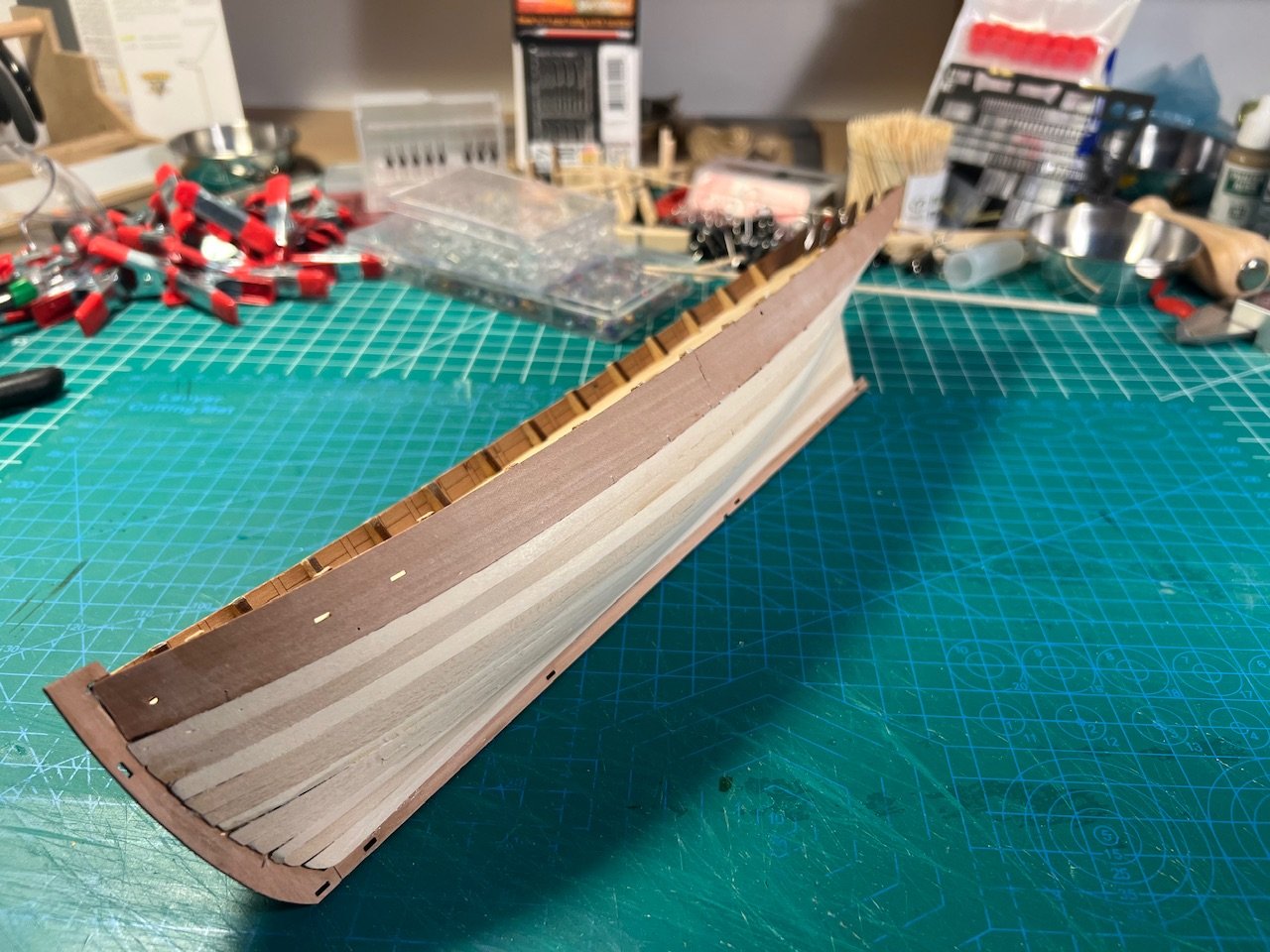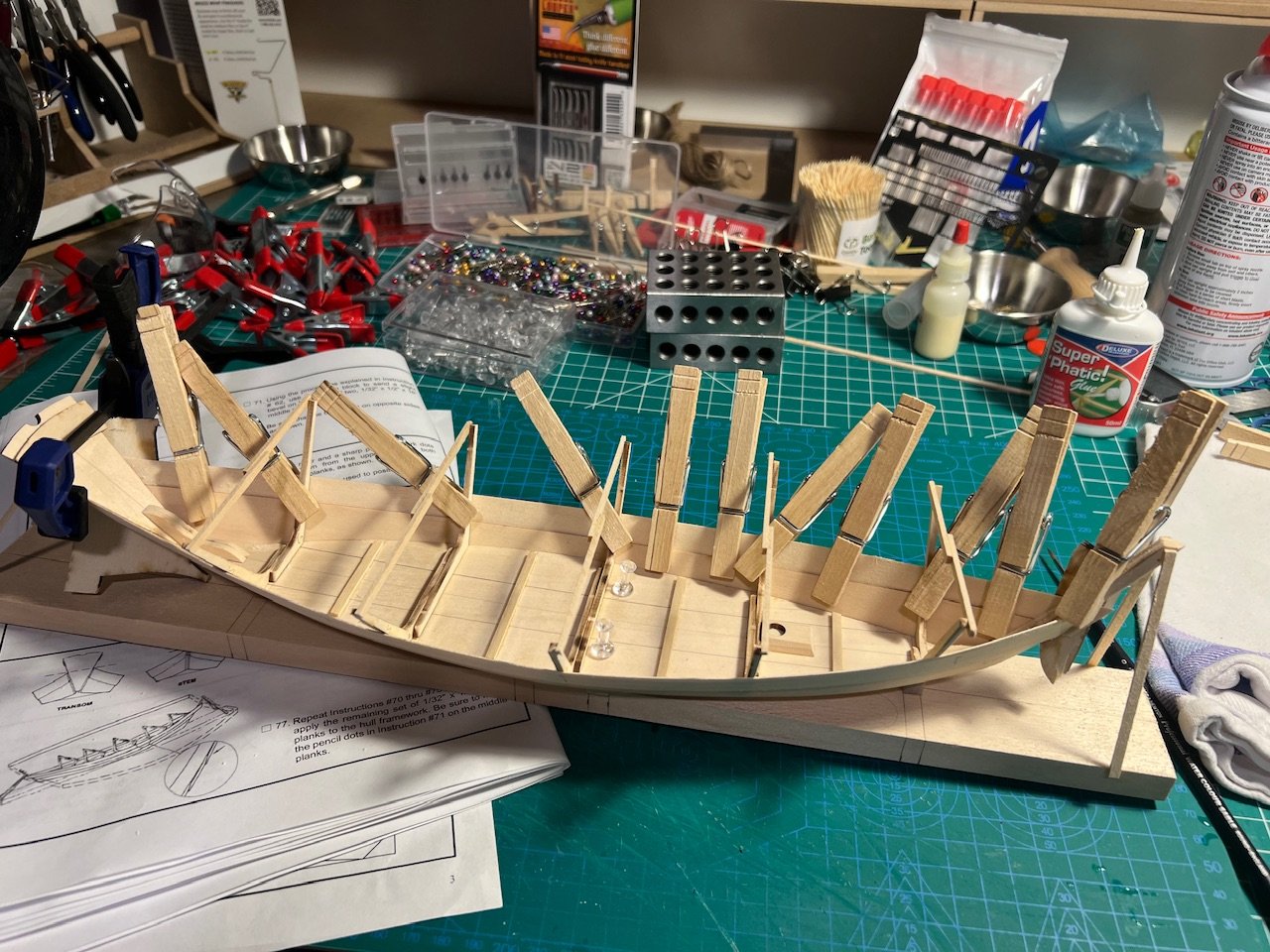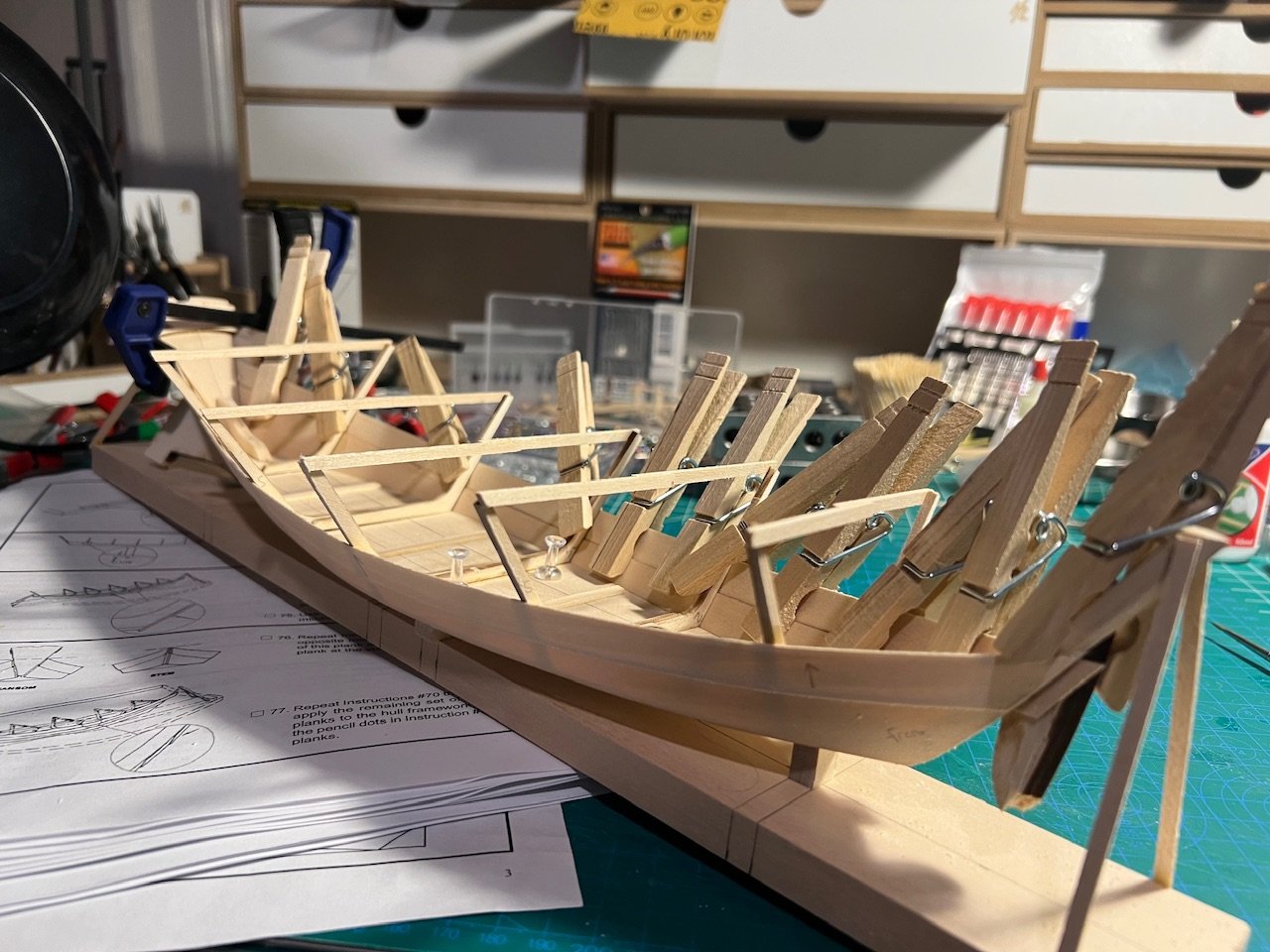
palmerit
NRG Member-
Posts
1,034 -
Joined
-
Last visited
Content Type
Profiles
Forums
Gallery
Events
Everything posted by palmerit
-
- 71 replies
-
- grand banks dory
- midwest products
-
(and 2 more)
Tagged with:
-
I (and others) often recommend Vanguard Models. The Sherbourne is a great kit. They also have a bunch of fishing boats, most of which are for beginners (I’m doing the Ranger now). They’re a little more expensive than some others but the instructions and materials are great. Chris Watton says he barely makes a profit on the Sherbourne kit. I’ve also done the Model Shipwright series (Dory, Pram, and Smack). They’re a nice collections. The construction of the Occre kit is I think going to be more similar to the Vanguard kits - in terms of its planked hull and rigging.
-
- 133 replies
-
- Ranger
- vanguard models
-
(and 1 more)
Tagged with:
-
After losing pieces in the rug, I put a new crisp white drop cloth under my work area. Makes it easier to find pieces and keeps the rugs safe (not just from glue and paint but also from when you stab yourself in the hand with a razor blade and bleed all over yourself).
-
In the Model Shipways version of the Smack, I also had trouble with the Britannia metal garbage fittings they provided. Thankfully, the metal cleats that came with that weren't quite as awful as the ones you showed (I had to do a bunch of filing and reshaping because they all looked like different pieces). But there were some other metal fittings that were used in the rigging (that had a hook on one end that attached to an eyebolt and a hole on the other end that accepted a tied off piece of rigging - don't know what they are called) that had holes way to small to accept any rigging line supplied with the kit and after I tried to bore the hole out a bit to get the line through and added to the rigging the piece came apart in my hands. You'd think they would have discovered 3D printing by now. Are there third party vendors that sell quality cleats and fittings like that? Who is your "hobby supplier"? I know you can get great rope and blocks from places like Syren. I haven't seen a place where I can replace poor metal fittings for cleats and other parts.
- 34 replies
-
- muscongus bay lobster smack
- Model Shipways
-
(and 1 more)
Tagged with:
-
- 71 replies
-
- grand banks dory
- midwest products
-
(and 2 more)
Tagged with:
-
- 133 replies
-
- Ranger
- vanguard models
-
(and 1 more)
Tagged with:
-
- 133 replies
-
- Ranger
- vanguard models
-
(and 1 more)
Tagged with:
-
- 71 replies
-
- grand banks dory
- midwest products
-
(and 2 more)
Tagged with:
-
Now that I’ve added the outside frame piece on the transom, it seems I didn’t fair the back end like I should have. I’m thinking I should remove the glue from the bulwark at the rear and sand down and reattach after.
- 133 replies
-
- Ranger
- vanguard models
-
(and 1 more)
Tagged with:
-
One thing future builders of this and similar models might pay attention to is that it is really easy to bang the stern transom. With these pieces being ply, and not hardwood, it is then easy for them to flake. I’m going to try to add some wood filler and do some sanding. Next model like this I’m going to try to remember to put some bubble wrap in the area.
- 133 replies
-
- Ranger
- vanguard models
-
(and 1 more)
Tagged with:
-
In anticipation of adding pear pieces at the prow that will create a rabbet/chamfer for the second layer of planking, I tried to sand down the first layer planking at the prow a good bit. And in anticipation of adding pieces at the stern and counter that the second layer of planking will need to lay flush with, I tried to sand down the first layer of planking at the stern a good bit. I’m hoping my instincts are right. One thing I know I would have missed if I hadn’t done the NRG half hull and read a bunch of build logs was that the first layer of planking does not go all the way to the end of the stern. Another piece will be added to create what would be a chiseled rabbet/chamfer on some models. The instructions show this, and I followed, but I don’t think there was explicit note of this.
- 133 replies
-
- Ranger
- vanguard models
-
(and 1 more)
Tagged with:
-
First layer of planking on the Ranger done. This is my second strip planking after the Sherbourne. Definitely better than the first (and second) planking of the Sherbourne but still have to get more practice. The instructions say no water/heat/bending required but some of the planks, especially 2/3 way down the hull needed it. I got a bit of clinkering (not as bad as on the Sherbourne). I’ll definitely be doing some bending on the 2nd planking in pear. Might also give CA glue another try.
- 133 replies
-
- Ranger
- vanguard models
-
(and 1 more)
Tagged with:
-
Slow progress on the Dory - just haven’t had time to work on any models. Added a couple more planks. The Midwest Dory is twice the size of the Model Shipways Dory (about the same length as my Sherbourne).
- 71 replies
-
- grand banks dory
- midwest products
-
(and 2 more)
Tagged with:
-
Model Expo will give you a credit for the Dory to use for a future purchase at Model Expo if you send them a photo of you and your model - I even got it purchasing the three-kit combo pack and purchasing it on Amazon and not directly from Model Expo: https://modelexpo-online.com/free-dory-promo.html?srsltid=AfmBOorrryRtIO4jVYHTHipdmJzYyjzY1CldRiCPgoWM4No9I2bVHn0c
-
New to ship modelling? But what do you build first?
palmerit replied to MSW's topic in Wood ship model kits
One piece of advice I remember reading when I was just starting - which was not long ago - was to treat each step of building a model ship as its own "project". That could mean adding a plank, shaping a mast, rigging a block. As you've seen, these models can take a long time to build - they're not just a weekend project. The Polaris says 120 hours. And as others have said, you can always fix a mistake on a wooden model. I wasn't put off by the amount of time it might take to build one of these models - in fact, it was an advantage for me because I wanted something I could get immersed in over the long run. I am glad I didn't try to tackle a model that would far exceed my capabilities because I probably would have had a 1/2 finished model packed away in the cellar. If I hadn't checked out this web site, I probably would have bought something far beyond my capabilities. The Polaris shows an all-wood model, which requires a really nice planking job that few novices would be able to pull off - I certainly couldn't. But you can always paint the hull, which would then allow a lot of filler and sanding. If you look at my Sherbourne, the planking was kind of garbage, but the end result after painting was fine. -
New to ship modelling? But what do you build first?
palmerit replied to MSW's topic in Wood ship model kits
I have an order in the queue for the Pavel Nikitin Oseberg - which will probably sit in my stash for a while - and it's shipping from Ukraine was nearly $100. -
New to ship modelling? But what do you build first?
palmerit replied to MSW's topic in Wood ship model kits
The Model Shipways Shipwright Combo (Dory, Pram, Smack) is $149.99US and it comes with a bunch of tools (though I imagine you'll soon want to replace them with better ones) and paint (not the best paint, but it's free). Don't know what the shipping would be but you get 3 kits in on package. https://modelexpo-online.com/Model-Shipways-Shipwright-3-Kit-Combo-Series-with-Tools-Glue-and-Paint_p_5290.html -
New to ship modelling? But what do you build first?
palmerit replied to MSW's topic in Wood ship model kits
The Half Hull was a great learning experience for me, though you don't end up with a complete ship at the end. As the name implies, it's a half hull. Having to cut out the planks from sheets of basswood gives you a good appreciation for how you might have to bend (in three dimensions) strip planks (which are common in lots of kits). I will say that that was great to do after having first tried planking the Sherbourne (with small success and lots of filler and sanding, trying to digest lots of planking guides and build logs). I don't know what the shipping costs are for sending that kit overseas. The Model Shipways kits (Dory, Pram, Smack) give you already-shaped planks (that you snip out of a sheet) that you just have to bend into place in one dimension. The Half Hull has you cut out planks to the right size yourself from sheets. The Vanguard kits (and many others) give you strips of wood that are all the same size that you need to cut, trim, bend, and shape (often with water and heat) to fit the hull. Some hulls (like the Vanguard Ranger) are fairly simple, the Sherbourne is a tiny bit more complicated, and more advanced kits (that I haven't attempted) are even trickier to plank. I know I'm not saying anything most people on here don't already know. But these were dimensions of difference that I was completely clueless about when I first started not so long ago. -
You used these in your airbrush? Are these (like the Vallejo) acrylics? Or enamel? Since I paint inside the house (with an airbrush booth) I’ve avoided enamels. (The only exception is that I’ve used Tamiya enamel primer - from shake spray can - on PE because the Vallejo primer peeled right off PE.)
- 34 replies
-
- muscongus bay lobster smack
- Model Shipways
-
(and 1 more)
Tagged with:
-
With regular Vallejo air paints I have my airbrush at 25psi or so. With Vallejo primers, cranking up to 40psi works for me. I also thin both paints and primers by 50% with a 7:3:1 combo of flow-improver:thinner:retarder.
- 34 replies
-
- muscongus bay lobster smack
- Model Shipways
-
(and 1 more)
Tagged with:
-
New to ship modelling? But what do you build first?
palmerit replied to MSW's topic in Wood ship model kits
True. That's why I ended up doing some Model Shipways kits while continuing to work on my Vanguard Sherbourne. Too bad the Model Shipways kits are too expensive in Europe - I'm surprised they don't have a European vendor. Their Shipwright series of three boats is a nice trio of started kits (despite some frustrations with the material and instructions). The biggest mistake will probably be with planking. My first planking of the Sherbourne was a mess. The second planking of the Sherbourne hardly better. I've done better on later kits. It definitely takes practice. One nice thing is that for any beginner kits, you'll likely be painting the hull anyway and there's not much you can't fix with wood filler and sanding. My final Sherbourne hull doesn't even look like what I started with. Definitely read build logs and tutorials on planking (including the ones linked on the Articles Database at the top of this web site). But you eventually you need to just try the planking and make mistakes. One thing nice about wooden model ship kits as that you can always unglue things (with the right solvent). And you can usually remake parts with scrap wood, which is good practice for what it might be like to kit bash or scratch build. On my Sherbourne, I certainly messed something up somewhere because the parts on the side at the rear of the ship did not line up right. So I ended up making some parts from scratch and used filler and paint and I don't think most people would be able to tell that I ever made a mistake or what mistake I made. I've made plenty of mistakes on the few kits I've worked on and I've never been able to undo any of them or get around them in some way or the mistakes just add some character to my finish result. -
New to ship modelling? But what do you build first?
palmerit replied to MSW's topic in Wood ship model kits
The Vanguard Sherbourne and Vanguard fishing boats (with the reddish sails, there are six varieties - the Saucy Jack is one of them) are a great first model. Definitely take serious the ratings and start with a novice kit. There is so much to learn. I almost jumped up a couple levels for my second build but then decided instead to build some additional simpler boats first. Most of the Vanguard models do have a mast but the materials are great and the instructions clear. You can download (for free) the instructions on the Vanguard web site (https://vanguardmodels.co.uk) and check them out. I'd recommend picking a model that has a lot of build logs here - that means a lot you can learn from and folks who built (or are building) can answer questions. This page has a fairly up-to-date index of various ships (by year range) of all the build logs : While the original post date was 2017, the first post was last updated a couple months ago. -
new kit alert! New kit on the horizon - Winchelsea Nef
palmerit replied to James H's topic in Wood ship model kits
When you order one of his models you can order the paint/stain set too - I'm guessing it comes with some explanation for how to achieve that look.- 15 replies
-
- winchelsea
- medieval
-
(and 1 more)
Tagged with:
About us
Modelshipworld - Advancing Ship Modeling through Research
SSL Secured
Your security is important for us so this Website is SSL-Secured
NRG Mailing Address
Nautical Research Guild
237 South Lincoln Street
Westmont IL, 60559-1917
Model Ship World ® and the MSW logo are Registered Trademarks, and belong to the Nautical Research Guild (United States Patent and Trademark Office: No. 6,929,264 & No. 6,929,274, registered Dec. 20, 2022)
Helpful Links
About the NRG
If you enjoy building ship models that are historically accurate as well as beautiful, then The Nautical Research Guild (NRG) is just right for you.
The Guild is a non-profit educational organization whose mission is to “Advance Ship Modeling Through Research”. We provide support to our members in their efforts to raise the quality of their model ships.
The Nautical Research Guild has published our world-renowned quarterly magazine, The Nautical Research Journal, since 1955. The pages of the Journal are full of articles by accomplished ship modelers who show you how they create those exquisite details on their models, and by maritime historians who show you the correct details to build. The Journal is available in both print and digital editions. Go to the NRG web site (www.thenrg.org) to download a complimentary digital copy of the Journal. The NRG also publishes plan sets, books and compilations of back issues of the Journal and the former Ships in Scale and Model Ship Builder magazines.

